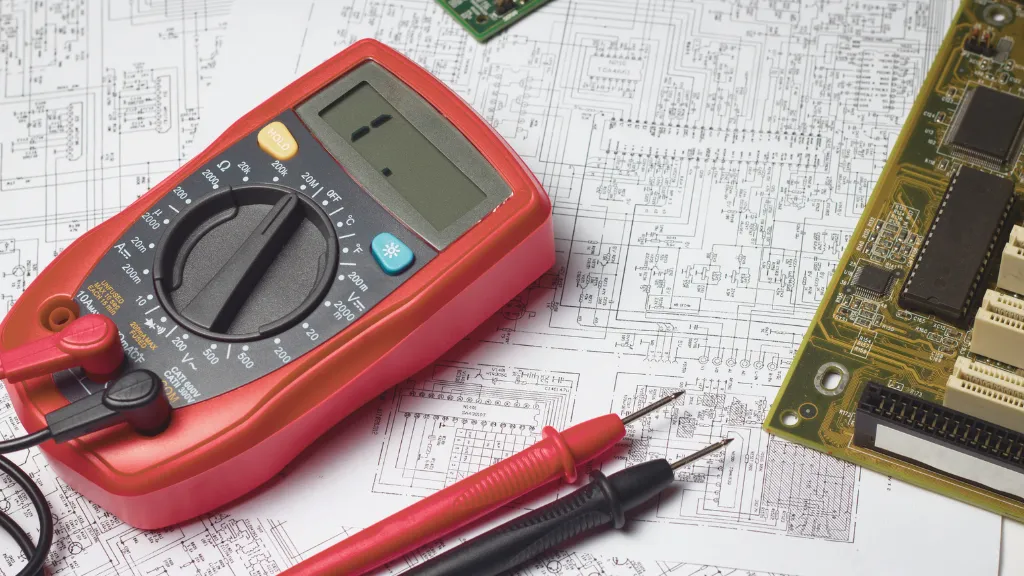How To Test C Batteries With a Multimeter
In all their shapes and sizes, batteries are the unsung heroes of the electronic world. C batteries are widely used in various devices, from children’s toys to portable radios.
However, like all batteries, they can wear out over time. Testing a C battery with a multimeter is a quick and easy way to ensure it’s still holding charge and functioning as expected.
In this article, we’ll guide you through the steps to test a C battery using a multimeter, ensuring you can keep your devices running smoothly.
What Is A C Battery?
A C battery, often referred to as an R14 battery, represents a common dry cell battery size, typically employed in applications with medium energy demands.
Here are some key features and details about C batteries:
Physical Characteristics
- Size: C batteries are larger than AA and AAA batteries but smaller than D batteries. They typically measure about 50 mm (1.97 inches) in length and 26.2 mm (1.03 inches) in diameter.
- Shape: They are cylindrical and have a characteristic raised positive terminal at one end and a flat negative terminal at the other.

Electrical Specifications
- Voltage: The standard voltage for a C battery is 1.5 volts for single-use or primary batteries.
- Capacity: They generally have a higher capacity (amount of electric charge they can store) than smaller batteries like AA and AAA. This makes them suitable for devices that require more power.
Types and Applications
- Alkaline Batteries: The most common type of C batteries are alkaline, ideal for regular use in various household devices.
- Rechargeable Batteries: Rechargeable variants, such as Nickel-Metal Hydride (NiMH), are also available and can be more cost-effective over time.
- Applications: They are commonly used in devices like toys, flashlights, portable music players, and other medium-drain electronic devices.
Understanding Your Multimeter
What is a Multimeter?
A multimeter is a handy tool that combines several measurement functions in one unit. It can measure voltage, current, and resistance. For testing batteries, we’ll focus primarily on the voltage measurement function.
Preparing Your Multimeter for Use
Before testing your C battery, set your multimeter to the DC (Direct Current) voltage setting. This is usually indicated by a V with a straight line. Also, ensure that the red lead is connected to the positive terminal (usually marked with a “+” or “VΩmA”) and the black lead to the common terminal (usually marked as “COM”).

How To Test C Batteries With a Multimeter
Step 1: Check the Battery’s Nominal Voltage
Firstly, knowing the nominal voltage of the C battery you are testing is essential. Most C batteries are rated at 1.5 volts when fully charged.
Step 2: Connect the Multimeter Leads
To accurately test your C battery using a multimeter, it’s crucial to establish a proper connection between the multimeter leads and the battery terminals. Here’s a more detailed breakdown:
Positioning the Battery
Start by placing the C battery on a stable, non-conductive surface. Ensure the battery’s positive (+) and negative (-) ends are visible and accessible.
Handling the Multimeter Leads
The multimeter comes with two leads: a red lead for the positive terminal and a black lead for the negative terminal. It’s essential to use these leads correctly to obtain an accurate reading.
Connecting to the Battery Terminals
- Negative Terminal: Take the black lead and gently press its tip against the battery’s negative (-) end. The negative end is usually flat and marked with a minus (-) sign. Ensure that the lead makes good contact with the terminal.
- Positive Terminal: Similarly, take the red lead and place its tip firmly against the positive (+) end of the battery. This end is typically marked with a plus (+) sign and may have a raised nub or bump.
Ensuring Secure Contact
- Steady Hold: Hold both leads securely against the battery terminals. It’s important not to let them slip or move during testing, as this can result in inaccurate readings.
- Gentle Pressure: Apply gentle pressure to ensure a good connection, but avoid pressing too hard, as this could damage the battery terminals or the multimeter leads.
Step 3: Read the Voltage Measurement
Once you’ve properly connected the multimeter leads to the C battery, the next crucial step is to accurately read and interpret the voltage measurement displayed on the multimeter. This step is vital in determining your battery’s health and charge level.
Observing the Multimeter Display
- Locate the Display: Focus on the multimeter’s display screen, where the voltage reading will appear.
- Reading the Value: The display will show a number with a decimal point representing the battery’s voltage. This is usually in the format of XX.XX volts.
Understanding the Display Reading
- Direct Reading: The value displayed directly measures the voltage across the battery terminals.
- Decimal Points: Pay attention to the decimal points as they provide a precise measurement. For instance, a reading of 1.55 volts differs from 1.5 volts regarding battery health.
Accuracy of the Measurement
- Stable Reading: Ensure that the reading on the display is stable. A fluctuating reading could indicate a poor connection or a problem with the battery.
- Repeat Measurements: If in doubt, disconnect the leads and reconnect them to take another reading. Consistency in readings is key to accurate measurement.
Interpreting Different Readings
- Above 1.5 Volts: A slightly above 1.5 volts reading typically indicates a healthy, fully charged C battery.
- Exactly 1.5 Volts: This is the nominal value for a new or fully charged C battery.
- Below 1.5 Volts: Readings below 1.5 volts suggest that the battery has been partially or completely discharged. The lower the reading, the less charge the battery holds.
Special Cases
- Digital vs. Analog Multimeters: If you’re using an analog multimeter, the reading will be on a scale rather than a digital display. Ensure you read the scale corresponding to the DC voltage setting.
- No Reading: If the multimeter shows no reading or a very low reading close to zero, it could indicate that the battery is dead or there is an issue with the connection.
Step 4: Interpret the Results
Above 1.5 Volts
- New or Overcharged Battery: A reading slightly above 1.5 volts is common in new batteries or batteries that have been recently charged. It’s a sign of a healthy battery with full charge capacity.
- Caution with Rechargeable Batteries: Testing a rechargeable C battery that consistently shows a much higher voltage than expected could indicate overcharging, reducing the battery’s lifespan.
Around 1.5 Volts
- Fully Functional Battery: A reading of approximately 1.5 volts indicates a healthy battery in optimal condition. It should function effectively on most devices.
- Ideal for Critical Devices: Batteries showing this voltage are best used in devices where optimal performance is crucial, like medical devices or safety equipment.
Between 1.2 to 1.5 Volts
- Partially Discharged: This range suggests that the battery has been partially used but still holds a significant charge. It may still be suitable for low-drain devices.
- Reduced Efficiency: While the battery can still be used, its efficiency in high-drain devices might be compromised. Expect shorter usage durations in such cases.
Below 1.2 Volts
- Significantly Discharged or Dead: A voltage below 1.2 volts indicates a significantly discharged or dead battery. It is unlikely to function effectively on most devices.
- Replacement Recommended: Batteries with such readings should be replaced, especially if they are non-rechargeable. Even rechargeable batteries may have reached the end of their life cycle.
Despite their higher capacity, why are C batteries less common in everyday devices than AA or AAA batteries?
Despite their higher capacity and longer life, C batteries are less common in everyday devices than AA or AAA batteries, primarily due to their size and the evolving nature of electronic devices. As technology has advanced, there has been a significant trend towards miniaturization and efficiency in electronic design.
This shift has favored smaller batteries like AA and AAA, which balance power and compactness well.
Moreover, many modern devices are designed to be more energy-efficient, reducing the need for the higher capacity that C batteries offer. As a result, manufacturers often opt for smaller batteries to keep devices lightweight and portable.
However, it’s important to note that C batteries still hold a significant place in powering medium-drain devices such as toys, musical instruments, and some emergency equipment, where their longer lifespan and robust power output are advantageous. They offer a reliable power source when changing batteries frequently is not ideal, ensuring that devices function effectively for extended periods.
Conclusion
Testing C batteries with a multimeter is a simple and effective way to assess their health and usability. It helps you avoid the frustration of dead batteries in your devices and ensures you’re always prepared with a working battery.
Remember, a multimeter is not just a tool for professionals; it’s a valuable instrument for everyday use in maintaining your electronic devices.
Frequently Asked Questions
Why is my battery reading above 1.5 volts?
New batteries can have a slightly higher voltage than their rated voltage. This is normal and not a cause for concern.
Can I test rechargeable C batteries with a multimeter?
Yes, you can test rechargeable C batteries similarly. However, their full charge voltage might differ from standard alkaline batteries.
What does a zero reading mean?
A zero reading usually indicates that the battery is completely dead or that there’s a poor connection between the leads and the battery terminals.
Is it safe to test batteries with a multimeter?
Yes, it’s safe to handle the multimeter correctly and ensure the leads are connected to the appropriate terminals.

Author
Alex Klein is an electrical engineer with more than 15 years of expertise. He is the host of the Electro University YouTube channel, which has thousands of subscribers.
